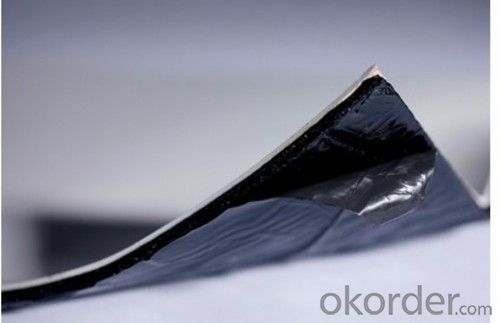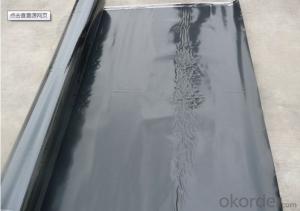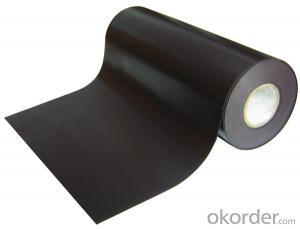EPDM Waterproofing Membrane Used in Roofing Field
- Loading Port:
- China main port
- Payment Terms:
- TT OR LC
- Min Order Qty:
- 5000 m²
- Supply Capability:
- 100000 m²/month
OKorder Service Pledge
OKorder Financial Service
You Might Also Like
Specification:
Tensile Strength N/CM | Normal temperature: 60 ; 60°C: 30 |
Breaking Elongation % | Normal temperature: 400 ; -20°C: 10 |
Tear Resistance N | 20 |
Impermeability, 30 min no leakage | 0.3Mpa |
Low Temperature Bending °C | -20 |
Heating Shrinking mm | Extension: 2 Shrink: 4 |
Heat Resistance (80°C×168h) | Tensile Strength % : 80 ; Keeping rate of adhesive breaking:70 |
Alkali resistance (10% ca (oh)2 solution,normal temperature ×168h)) | Tensile Strength % : 80 ; Keeping rate of adhesive breaking:80 |
Synthetic aging | Tensile Strength % : 80 ; Keeping rate of adhesive breaking:80 |
Characteristic:
1.Excellent anti aging performance ,service life up to 50 years.
2.High extension rate,high tensile strength ,small size changes at heat treatment.
3.Good plant roots penetrability resistance and can be made waterproofing layer of planting roof.
4.Special modified molecular structure ,effectively resolving the current domestic and foreign glue joint problem.
5.Good low temperature flexibility ,and good performance of adapting to ambient temperature changes.
6.Convenient application ,solid joint ,no environment pollution.
7.Chemical corrosion resistance ,can be used for special occasions.
8.Good anti-perforated.
Applicable scope:
1.0mm 1.2mm 1.5mm 1.8mm 2.0mm EPDM waterproof membrane is widely used in roofs, basement, toilet, swimming pool, and all kinds of industry and civil building waterproofing, reservoir, bridge, underground, tunnel and dam waterproofing, especially to the keystone waterproofing projects which is durability, high corrosion resistance and easy deformation.
FAQ of Waterproofing Membrane
a.Can we get some samples before place order?
Answer: We can send the free samples to you by freight collect.
b.How many years can your PVC membrane guarantee?
Answer: We will guarantee the quality for 5 years at least.
c.Which countries you ever export the product?
Answer: We export the PVC membrane to South Africa, Middle east and even European countries.

- Q:Are there any limitations to using a waterproofing membrane?
- Yes, there are some limitations to using a waterproofing membrane. Firstly, while waterproofing membranes are effective in preventing water penetration, they are not always a solution for structural issues that may cause leaks. If there are underlying problems with the structure, such as cracks or gaps in the foundation or walls, a waterproofing membrane alone may not be sufficient to address the issue. Secondly, the installation of a waterproofing membrane requires proper surface preparation, which can be time-consuming and costly. The surface needs to be clean, dry, and free from any debris or contaminants for the membrane to adhere properly. If the surface is not adequately prepared, the membrane may not adhere correctly and could fail to provide effective waterproofing. Furthermore, waterproofing membranes can be susceptible to damage during installation or afterwards if not properly maintained. Sharp objects or heavy equipment can puncture or tear the membrane, compromising its effectiveness. Regular inspections and maintenance are necessary to ensure the membrane remains intact and in good condition. Additionally, waterproofing membranes have a limited lifespan and may deteriorate over time. Exposure to UV radiation, extreme temperatures, or harsh chemicals can degrade the membrane, reducing its ability to prevent water penetration. Regular inspections and potential replacement may be required to maintain the waterproofing integrity. Lastly, waterproofing membranes are not always suitable for all types of structures or environments. Some membranes may not be compatible with certain substrates or may not be able to withstand high hydrostatic pressure. It is essential to consult with a professional and choose the right type of membrane for the specific project and conditions. Overall, while waterproofing membranes can be highly effective in protecting structures from water damage, it is important to consider their limitations and ensure proper installation and maintenance to maximize their performance.
- Q:Can waterproofing membranes be used on roofs?
- Yes, waterproofing membranes can be used on roofs. Waterproofing membranes are specially designed materials that are used to provide a protective layer on roofs to prevent water penetration. These membranes are typically made of materials such as modified bitumen, EPDM, PVC, or TPO, which are highly resistant to water and can effectively seal the roof. They are commonly used in both residential and commercial applications, including flat roofs, low-slope roofs, and even sloped roofs with certain designs. Waterproofing membranes are applied in multiple layers to ensure maximum protection against water damage and can greatly extend the lifespan of a roof by preventing leaks and moisture buildup.
- Q:Can a waterproofing membrane be used in chemical or hazardous environments?
- Yes, a waterproofing membrane can be used in chemical or hazardous environments. Waterproofing membranes are designed to provide a barrier against water, moisture, and other liquids, which can also include chemicals and hazardous substances. These membranes are typically made of materials that are resistant to chemicals, such as polyurethane, PVC, or modified bitumen, to ensure they can withstand exposure to various chemicals without being damaged or compromised. However, it is important to select a waterproofing membrane specifically designed for chemical or hazardous environments to ensure it meets the necessary requirements and standards for such applications. Additionally, proper installation and maintenance are crucial to ensure the effectiveness and longevity of the waterproofing membrane in these environments.
- Q:Can a waterproofing membrane be pre-fabricated or pre-made for easy installation?
- Yes, a waterproofing membrane can be pre-fabricated or pre-made for easy installation. In fact, many manufacturers offer pre-made waterproofing membranes that are specifically designed to simplify the installation process. These membranes are typically manufactured in controlled factory conditions, ensuring consistent quality and reducing the potential for errors during installation. Pre-fabricated waterproofing membranes are made from various materials such as bitumen, PVC, EPDM, or TPO, and come in different forms such as sheets or rolls. They are designed to be easily transported and installed on-site. The advantages of using pre-fabricated waterproofing membranes include increased efficiency, reduced labor costs, and improved installation quality. By eliminating the need for on-site fabrication, contractors can save time and resources. Additionally, pre-made membranes often come with detailed installation instructions, making it easier for contractors to ensure proper installation. Furthermore, pre-fabricated waterproofing membranes can be tailored to fit specific project requirements, such as size, shape, or slope. This customization helps to ensure a seamless and effective waterproofing solution. Overall, using pre-fabricated or pre-made waterproofing membranes can significantly simplify the installation process and provide a reliable and durable waterproofing solution for various applications, including roofs, basements, and foundations.
- Q:Can a waterproofing membrane be used in conjunction with soundproofing materials?
- Yes, a waterproofing membrane can be used in conjunction with soundproofing materials. In fact, it is quite common to use both of these materials together in construction projects. Waterproofing membranes are typically used to prevent the penetration of water into a structure, while soundproofing materials are used to reduce noise transmission. These two materials serve different purposes but can be used simultaneously to provide both waterproofing and soundproofing benefits. For example, in a building with a basement or a bathroom, a waterproofing membrane can be installed on the walls or floors to prevent water infiltration, and then soundproofing materials can be added on top of the membrane to reduce noise transmission from adjacent areas. By combining these two materials, a building can be protected from water damage while also providing a quieter and more comfortable environment for its occupants.
- Q:Can a waterproofing membrane be used for a shower pan?
- Yes, a waterproofing membrane can be used for a shower pan. It helps to prevent water leakage and protect the underlying structure from moisture damage.
- Q:Can a waterproofing membrane be installed on any surface?
- When installing a waterproofing membrane, there are several factors to take into account. The condition and composition of the surface, as well as the type of membrane being used, determine its suitability. Typically, waterproofing membranes are designed to adhere to various substrates like concrete, wood, metal, and masonry. They can be applied to surfaces such as roofs, foundations, basements, bathrooms, and balconies. However, it is crucial to ensure that the surface is clean, dry, and free from contaminants like dirt, debris, or loose materials before installing the membrane. In addition, certain surfaces may require additional preparatory work or primers to enhance adhesion and ensure a long-lasting waterproofing solution. For example, rough or uneven surfaces may need to be leveled or smoothed before applying the membrane. The specific requirements of the waterproofing system being used should also be considered. Different membranes have different application methods and compatibility with surfaces. Some membranes may be more suitable for horizontal surfaces like flat roofs, while others may be better suited for vertical surfaces like walls or foundations. Ultimately, it is recommended to consult a professional waterproofing contractor or refer to the manufacturer's guidelines to determine the compatibility of the membrane with a specific surface and ensure proper installation for optimal performance and longevity.
- Q:Can a waterproofing membrane be used on precast chrome surfaces?
- Yes, a waterproofing membrane can be used on precast chrome surfaces. Waterproofing membranes are often used to protect surfaces from water damage and prevent moisture from seeping into the structure. Precast chrome surfaces can also benefit from the application of a waterproofing membrane to ensure their longevity and durability. The membrane will create a barrier between the surface and any potential water intrusion, thereby protecting the precast chrome and maintaining its appearance and functionality. It is important to choose a waterproofing membrane that is compatible with chrome surfaces and follow the manufacturer's instructions for proper application.
- Q:Can a waterproofing membrane be used on wood surfaces?
- Yes, a waterproofing membrane can be used on wood surfaces. Waterproofing membranes are designed to create a barrier that prevents water from penetrating the surface they are applied to. While they are commonly used on concrete or masonry surfaces, they can also be used on wood surfaces to protect them from moisture damage. Applying a waterproofing membrane on wood surfaces can help prevent water absorption, which can lead to rot, warping, or decay. It is important to choose a waterproofing membrane that is specifically designed for wood, as it will provide the necessary protection while allowing the wood to breathe and retain its natural characteristics.
- Q:Can a waterproofing membrane be used for a fountain waterproofing system?
- A fountain waterproofing system can utilize a waterproofing membrane to prevent water infiltration and damage. This membrane acts as a barrier, made of materials like rubber, PVC, or bitumen, and is applied to surfaces such as concrete, stone, or masonry. To protect against water seepage and damage, a waterproofing membrane can be applied to the interior surfaces of the fountain. It acts as a protective layer, ensuring the water remains contained within the fountain and preventing leaks or seepage. Choosing a waterproofing membrane specifically designed for fountains or water features is crucial. It should be able to withstand constant water exposure and the unique conditions and chemicals present in a fountain environment. Proper installation and maintenance are also important for the effectiveness of the waterproofing membrane. Consulting with a professional waterproofing contractor or fountain specialist is recommended to assess your fountain's requirements and determine the most suitable membrane and installation method. Ultimately, a waterproofing membrane is an effective solution for maintaining a fountain system's structural integrity and preventing water-related damage.
1. Manufacturer Overview |
|
|---|---|
| Location | |
| Year Established | |
| Annual Output Value | |
| Main Markets | |
| Company Certifications | |
2. Manufacturer Certificates |
|
|---|---|
| a) Certification Name | |
| Range | |
| Reference | |
| Validity Period | |
3. Manufacturer Capability |
|
|---|---|
| a)Trade Capacity | |
| Nearest Port | |
| Export Percentage | |
| No.of Employees in Trade Department | |
| Language Spoken: | |
| b)Factory Information | |
| Factory Size: | |
| No. of Production Lines | |
| Contract Manufacturing | |
| Product Price Range | |
Send your message to us
EPDM Waterproofing Membrane Used in Roofing Field
- Loading Port:
- China main port
- Payment Terms:
- TT OR LC
- Min Order Qty:
- 5000 m²
- Supply Capability:
- 100000 m²/month
OKorder Service Pledge
OKorder Financial Service
Similar products
New products
Hot products
Related keywords



























